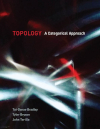- About MAA
- Membership
- MAA Publications
- Periodicals
- Blogs
- MAA Book Series
- MAA Press (an imprint of the AMS)
- MAA Notes
- MAA Reviews
- Mathematical Communication
- Information for Libraries
- Author Resources
- Advertise with MAA
- Meetings
- Competitions
- Programs
- Communities
- MAA Sections
- SIGMAA
- MAA Connect
- Students
- MAA Awards
- Awards Booklets
- Writing Awards
- Teaching Awards
- Service Awards
- Research Awards
- Lecture Awards
- Putnam Competition Individual and Team Winners
- D. E. Shaw Group AMC 8 Awards & Certificates
- Maryam Mirzakhani AMC 10 A Awards & Certificates
- Two Sigma AMC 10 B Awards & Certificates
- Jane Street AMC 12 A Awards & Certificates
- Akamai AMC 12 B Awards & Certificates
- High School Teachers
- News
You are here
Topology: A Categorical Approach

Publisher:
MIT Press
Publication Date:
2020
Number of Pages:
166
Format:
Paperback
Price:
35.00
ISBN:
9780262539357
Category:
Textbook
[Reviewed by , on ]
Bernard Badzioch
07/4/2021
Instructors of advanced undergraduate and beginning graduate topology courses find themselves with a happy dilemma of having several well-written texts to choose from to accompany their lectures. Topology by Munkres, Introduction to Topological Manifolds by Lee, and Elementary Topology Problem Textbook by Viro et al., are just a few notable options.
Topology: A Categorical Approach aims to extend this selection even further. The topological material it presents is fairly standard, starting with the notions of a topological space and a continuous function, going through various constructions of topological spaces, introducing a few topological invariants (connectedness, path connectedness, compactness) and culminating with the fundamental group of a space. However, its distinguishing feature - indicated in the title - is the emphasis it puts from the very beginning on the categorical perspective on topology.
Since category theory is the language underlying much of modern mathematics, this is an interesting and credible take on the subject. This approach is also quite original. In other topology textbooks, categorical notions typically show up in the context of algebraic topology, where interactions between topological spaces and algebraic objects create a natural need for a formalism that can describe them. In this text though, categories and functors are present from the very first pages, and overall category theory content seems to occupy almost as much space as topology.
Topology is often perceived by students as a fairly abstract subject, and one may wonder if adding to it another layer of abstraction is advisable. The book makes a reasonable argument that it is, and that there is a benefit in a concurrent introduction to topology and category theory. Using this approach such notions as a subspace, product space, or quotient space are presented focusing on their universal properties instead of specifics of their constructions and are linked to the general framework of categorical limits and colimits. Cech-Stone compactification and the compact-open topology on function spaces are introduced in the context of adjoint functors. The fundamental group of a space is derived from the fundamental groupoid, and so on.
The inclusion of the category theory content and the relatively small size of the book necessitates tradeoffs. In effect, several topics one usually finds in textbooks on a similar subject are omitted. This includes separation axioms (with the exception of Hausdorff spaces), the Tietze extension theorem, sequential compactness, metrization, covering spaces etc. Other topics are only outlined. For example, the proof of the Siefert - van Kampen theorem is sketched in two brief paragraphs with details left to the reader. Cech-Stone compactification is presented using its formal properties as a left adjoint functor, but the proof that it exists is skipped. These are not flaws of this text, but conscious choices made by the authors whose principal aim is to emphasize content that involves as much category theory as it does topology.
The writing style of the book is lively and informal, and the text reads well. The informality, however, occasionally leads to imprecision. For example, in chapter 2 the authors show that any infinite subset of a compact space has a limit point (which is true), but then in chapter 3 they restate this by writing that every sequence in a compact space has a convergent subsequence (which is not true). In chapter 6 they prove that there is a bijection between the set of integers and the set of elements of the fundamental group of a circle, but then they take for granted that this bijection gives an isomorphism of groups, which does not follow from their proof. Similar issues appear with some frequency.
Another characteristic of the text that some readers may find a bit disorienting, is its somewhat non-linear structure: it frequently invokes notions that are explained only later. In most instances the authors explicitly indicate it and the reader can safely omit such passages, but they appear often enough that they can be distracting.
Overall, this book should work well in either of two roles. First, it can serve as a basis for a course, where the instructor can straighten occasional wrinkles and provide additional details or context as needed. Exercises included at the end of each chapter will be a useful feature in this setting. Additionally, the book may be of interest to a reader who already has experience with general topology and would like to supplement it with a categorical perspective. As the authors themselves suggest in the introduction, the book is not intended for self-study by someone who wants to learn topology with no prior exposure to it.
It is worth mentioning that the book is available online as an open-access text, which certainly increases its appeal.
Bernard Badzioch is an Associate Professor of Mathematics at the University of Buffalo. His area of expertise is algebraic topology.
See the publisher's website.
- Log in to post comments




